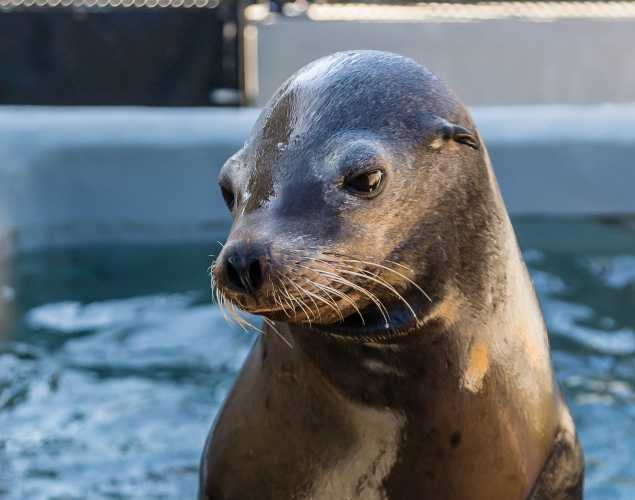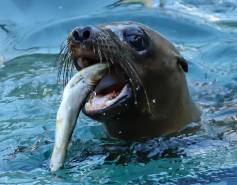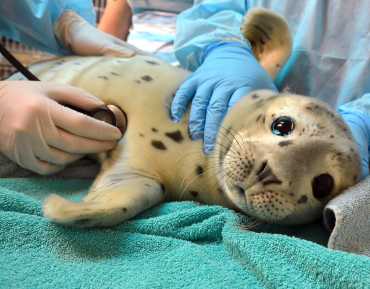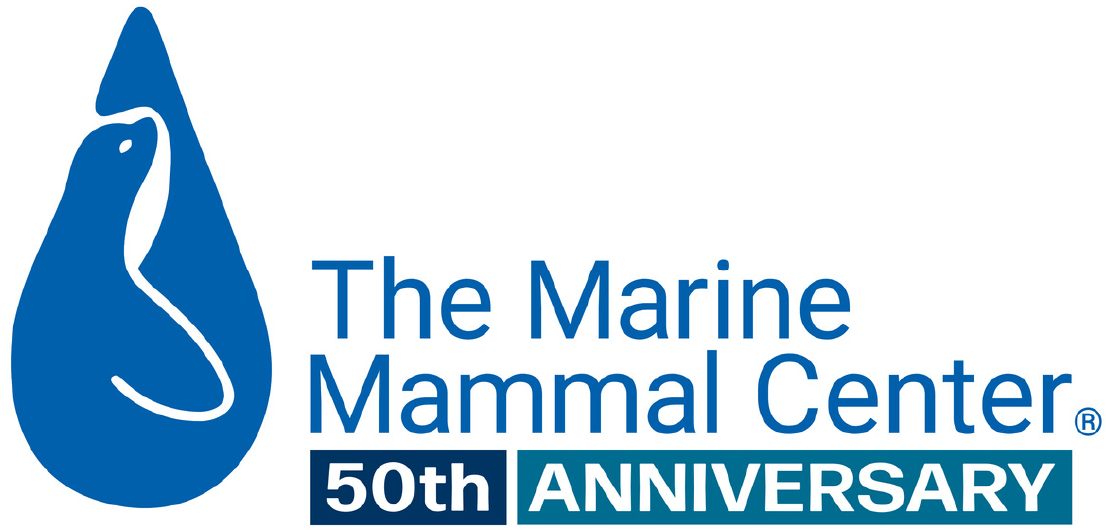
The Marine Mammal Center Responds to Second Largest Leptospirosis Outbreak on Record
- Leptospirosis
More than half of the California sea lions rescued this year have been suffering from effects of the bacteria that can cause fatal kidney damage.
Over the course of 2018, more than 220 California sea lions rescued by The Marine Mammal Center have been diagnosed with leptospirosis, a potentially fatal bacterial infection. That means we're in the middle of the second largest leptospirosis outbreak on record here at the Center.
During the last major outbreak in 2011, nearly 200 infected sea lion patients were admitted to our hospital. Based on historical data, we know that the majority of leptospirosis cases occur between July and November, peaking in August-September. So we expect to continue to see cases for the next few months.
Of the more than 10,000 calls The Marine Mammal Center’s Rescue Hotline receives every year, some are more routine than others. And during a major leptospirosis outbreak like the one the Center is facing right now, a lot of those calls sound very similar to the ones our rescue team received about Grazer.
Grazer was spotted on a beach in Monterey near the entrance to some condos. He was curled up by the sea wall with his flippers folded tightly over his abdomen, like a small child with a stomachache. That posture caused by abdominal pain and general malaise, sometimes called the “lepto pose,” is a classic sign the sea lion is suffering from the effects of a spiral-shaped bacteria called Leptospira.
The bacterial infection affects the kidneys and can be lethal if not treated. Another classic sign of the infection in sea lions is the desire to drink water. Marine mammals generally do not need to drink water because they receive all the hydration they need from food sources. But when they are infected with Leptospira, their kidneys stop functioning properly and cannot filter toxins or regulate hydration.
Leptospirosis is a major health burden for humans, domestic animals and wildlife worldwide with over 500,000 severe cases in humans every year. Leptospira can cause disease ranging from infection with no symptoms to severe and possibly fatal disease.
The type of Leptospira affecting California sea lions at The Marine Mammal Center is a strain that has also been associated with pigs, skunks and foxes. It’s transmitted via urine, either directly or via contaminated water or soil.
Researchers haven’t definitively determined how transmission occurs within the sea lion population, but they believe it occurs primarily while sea lions are hauled out on land. The bacteria may also survive for short periods in seawater, so transmission may be possible when large groups of sea lions gather in the water.
Sea lions diagnosed with leptospirosis are treated with antibiotics, fluids and other supportive care, such as gastroprotectants for stomach and intestinal ulcers. Unfortunately, even with treatment, roughly two-thirds of the animals that strand with acute leptospirosis do not survive.
However, research using data and samples collected at The Marine Mammal Center, as well as data collected from sea lions in the wild, indicates that many sea lions infected with Leptospira survive and likely experience mild or no symptoms of the disease, unlike in the acute cases seen at our hospital.
When a leptospirosis outbreak occurs, our scientists study the disease to learn more about what causes an outbreak and how we can improve treatment for infected animals. Thanks to the Center’s 43 years of stranding records and bank of blood and urine samples, researchers have a unique opportunity to investigate the disease patterns over four decades.
“We learn from every single patient we admit here at the Center,” says Dr. Shawn Johnson, Director of Veterinary Science at The Marine Mammal Center. “But it’s our long history of rehabilitation and our commitment to scientific research that allows us to see bigger picture impacts on the ocean environment.”
For over 10 years, scientists at The Marine Mammal Center have collaborated with researchers at the Lloyd-Smith Laboratory in the Department of Ecology and Evolutionary Biology at UCLA to study the dynamics of this pathogen in the California sea lion population. The Center has been at the forefront of research on leptospirosis in marine mammals and has published a number of scientific papers on the disease dating back to 1985.
Leptospirosis Research at The Marine Mammal Center
{"image":"\/Animals\/Patients\/California sea lions\/cropped-images\/csl-eating-by-bill-hunnewell-c-the-marine-mammal-center-0-361-1799-1405-1617816863.jpg","alt":"California sea lion eating a fish","title":"Predicting Prognosis in Wildlife Rehabilitation: A Case Study of Leptospirosis in Sea Lions","link_url":"https:\/\/www.marinemammalcenter.org\/publications\/predicting-prognosis-in-wildlife-rehabilitation-a-case-study-of-leptospirosis","label":"Research Paper","type":"publication"}

Predicting Prognosis in Wildlife Rehabilitation: A Case Study of Leptospirosis in Sea Lions
Read More{"image":"\/Animals\/Wild\/California sea lion\/cropped-images\/sea-lions-underwater-baja-shutterstock-186-4-4173-3260-1603919420.jpg","alt":"California sea lions underwater","title":"Seasonal Migration Contributes to Spread of Leptospirosis","link_url":"https:\/\/www.marinemammalcenter.org\/publications\/seasonal-migration-contributes-to-spread-of-leptospirosis","label":"Research Paper","type":"publication"}

{"image":"\/Animals\/Patients\/California sea lions\/cropped-images\/csl-by-bill-hunnewell-c-the-marine-mammal-center-7-0-1446-2827-2208-1603918668.jpg","alt":"California sea lion on pool ledge","title":"Effectiveness of Antibiotics in Treating Leptospirosis in California Sea Lions","link_url":"https:\/\/www.marinemammalcenter.org\/publications\/effectiveness-of-antibiotics-in-treating-leptospirosis-in-california-sea-lions","label":"Research Paper","type":"publication"}

Effectiveness of Antibiotics in Treating Leptospirosis in California Sea Lions
Read More{"image":"\/Animals\/Wild\/California sea lion\/cropped-images\/sea-lions-in-water-photo-c-bill-hunnewell-2140-212-1308-1022-1603918234.jpg","alt":"large group of California sea lions in the water","title":"Detecting the Spread of Leptospirosis Through Asymptomatic Carriers","link_url":"https:\/\/www.marinemammalcenter.org\/publications\/detecting-the-spread-of-leptospirosis-through-asymptomatic-carriers","label":"Research Paper","type":"publication"}

Leptospira was first detected in California sea lions in 1970 during a leptospirosis outbreak that occurred along the coast of California, Oregon and Washington. And since the 1980s, we have seen yearly, seasonal outbreaks with major outbreak events causing 100 or more sea lion strandings happening every four to five years.
The reasons for these periodic major outbreaks in sea lions is unknown, however our UCLA collaborators believe that a combination of factors may be responsible, such as changes in herd immunity, sea surface temperatures and sea lion migration patterns.
Interestingly, after 30 uninterrupted years of seeing at least a few cases of leptospirosis annually, the disease disappeared from the population in late 2013 only to reappear four years later.
“Thanks to our long-term collaboration with The Marine Mammal Center, we have an opportunity to investigate this highly unique situation during which a continuously circulating pathogen disappears from a wildlife host for a number of years and then reemerges,” says Dr. Katie Prager, a veterinarian and researcher from the Lloyd-Smith Laboratory. “This is a fascinating case study that we can use to learn more about infectious disease ecology and how outbreaks are impacted by environmental changes.”
Dr. Prager and her colleagues at UCLA believe the disappearance of the disease may be related to the highly anomalous oceanographic conditions that occurred during the same time period. The abnormally warm waters, commonly referred to as “the Blob,” may have caused changes in sea lion behavior and migration patterns as they struggled to find food sources.
This period of dramatic, out-of-the-ordinary ocean conditions has been described as a “climate change stress test” due to its unprecedented duration and intensity and such events are projected to become more common under future global change scenarios.
You may recall that these abnormal oceanographic conditions led to a large-scale stranding event in 2013-2017—what we dubbed the “sea lion tsunami”—in which we rescued unprecedented numbers of starving young sea lions. All told, thousands of sea lions stranded along the California coast during this multi-year period of warmer waters. Although oceanographic conditions have normalized in recent years, the impacts of this catastrophic event are still being felt in many ways.
“As climate change continues to wreak havoc on ocean health, causing more and more situations like we saw with ‘the Blob,’ it’s vital that we study the potential long-term implications of future environmental disturbances on ecosystem health and related issues, like infectious disease,” Dr. Johnson says.
Over the course of the next month, the Center’s biologists and veterinary staff will be working with Dr. Prager to take blood and urine samples from wild juvenile California sea lions at Año Nuevo Island. This popular haulout site located about a mile offshore is utilized by young California sea lions foraging for food after the summer breeding season.
The blood samples will tell researchers whether the sea lions have evidence of kidney disease and whether they are carrying antibodies that indicate past exposure to Leptospira while the urine samples can be tested for current infection. Once the samples are collected, the animals are tagged and released.
This collaborative research project also relies on long-term demographic datasets generated by our partners at the NOAA Fisheries Marine Mammal Laboratory. These biologists monitor and track pups born on the Channel Islands every year. We also work closely with biologists in Oregon and Washington who monitor the sea lions in those areas, and they’ve been reporting suspected cases of leptospirosis in recent months as well.
Many different animal species, including humans and dogs, can become infected with Leptospira through contact with contaminated urine, water or soil. The Marine Mammal Center has a number of safety protocols in place to prevent transmission to veterinarians and volunteers working with our sea lion patients.
Yes, I want to save a life!

Yes, I want to save a life!
You’ll be giving sick and injured animals the best possible care at the Center’s state-of-the-art hospital. With your gift today, you are giving a patient a second chance at life in the wild.
See Our Latest News
{"image":"\/Misc\/Graphics\/cropped-images\/climate-change-graphic-giant-earth-shutterstock-1798-6-5113-3994-1680046432.jpg","alt":"An Earth Day graphic of people holding the planet, recycling, planting a tree and moving a solar panel.","title":"5 Ways to Celebrate Earth Day","link_url":"https:\/\/www.marinemammalcenter.org\/news\/5-ways-to-celebrate-earth-day","label":"News Update","date":"2025-04-18 11:21:08"}

{"image":"\/Animals\/Wild\/Sea otter\/cropped-images\/sea-otter-mom-pup-photo-c-brian-simuro-505-0-3387-2646-1618247266.jpg","alt":"sea otter mother and pup","title":"Meaningful Mother\u2019s Day Gifts for Ocean Lovers","link_url":"https:\/\/www.marinemammalcenter.org\/news\/eco-friendly-mothers-day-gifts-that-give-back","label":"News Update","date":"2025-04-10 02:00:00"}

{"image":"\/Animals\/Wild\/Harbor seal\/cropped-images\/harbor-seals-shutterstock-107-0-1270-992-1744225508.jpg","alt":"A group of harbor seal pups and mothers on the beach during pupping season.","title":"Your Guide to Seeing Harbor Seal Pups in California","link_url":"https:\/\/www.marinemammalcenter.org\/news\/your-guide-to-seeing-harbor-seal-pups-in-california","label":"News Update","date":"2025-04-10 00:00:00"}

{"image":"\/Animals\/Wild\/Gray whale\/cropped-images\/a-dead-gray-whalesf-bay40225photo-by-josie-slaathaug-c-the-marine-mammal-center-noaa-permit-26532-123-0-1270-992-1743807892.jpg","alt":"stranded gray whale","title":"Scientists respond to two additional gray whales in San Francisco Bay","link_url":"https:\/\/www.marinemammalcenter.org\/news\/scientists-respond-to-two-additional-gray-whales-in-san-francisco-bay","label":"Press Release","date":"2025-04-04 02:00:00"}

Scientists respond to two additional gray whales in San Francisco Bay
April 4, 2025
Read MoreCalifornia Sea Lion
